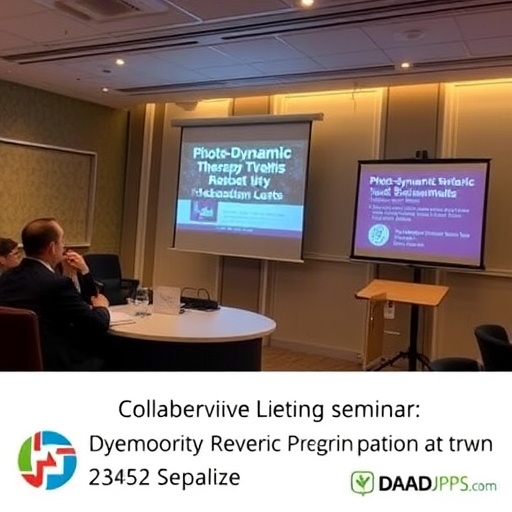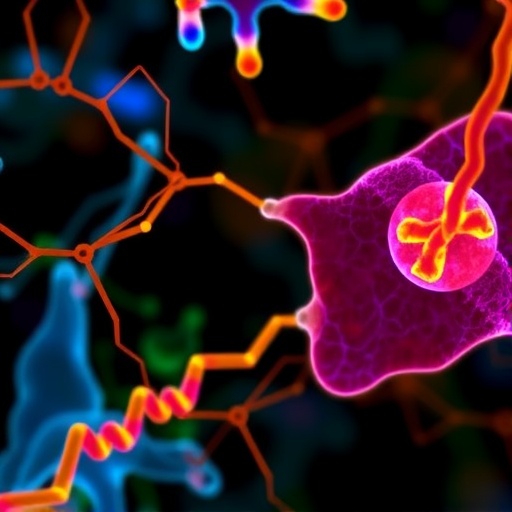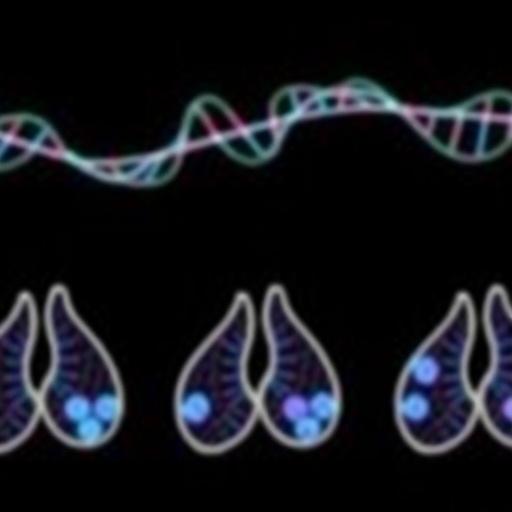
Innovation Center of NanoMedicine (iCONM), in collaboration with the University of Tokyo’s Nomoto Lab, is set to host a groundbreaking seminar that promises to shift paradigms in cancer treatment protocols, focusing on photodynamic therapy (PDT). Scheduled for September 19, 2025, this seminar aims to unveil pioneering research built around the intricate relationship between drug design and treatment rationalization via singlet oxygen imaging. Singlet oxygen, a highly reactive species generated during PDT, is garnering intense scientific attention as its precise imaging technology could be the key to optimizing therapeutic outcomes in oncology.
Photodynamic therapy operates on the principle of activating photosensitive compounds—photosensitizers—within targeted cancer cells through light irradiation, leading to the generation of reactive oxygen species, especially singlet oxygen. This reactive molecule induces cytotoxicity, resulting in tumor cell destruction. However, the success of PDT depends heavily on accurate measurement and understanding of oxygen dynamics within tumorous tissues, an area still fraught with challenges due to oxygen heterogeneity. The seminar will explore how singlet oxygen imaging serves not only as a monitoring tool but also as a direct marker of PDT efficacy, offering clinicians and researchers an unprecedented window into therapeutic processes.
The German contingent, represented by Adjunct Professor Steffen Hackbarth from Humboldt University of Berlin, will emphasize the critical importance of oxygen concentration within the tumor microenvironment during PDT. Hackbarth’s presentation on the innovative singlet oxygen imaging technique highlights how quantifying this elusive molecule can lead to precise calibration of treatment protocols. This research marries optical imaging technology with therapeutic assessment, thereby moving PDT from a largely empirical treatment toward a more exact science grounded in real-time molecular feedback.
.adsslot_qUMs3954KB{width:728px !important;height:90px !important;}
@media(max-width:1199px){ .adsslot_qUMs3954KB{width:468px !important;height:60px !important;}
}
@media(max-width:767px){ .adsslot_qUMs3954KB{width:320px !important;height:50px !important;}
}
ADVERTISEMENT
Complementing this perspective, Associate Professor Takahiro Nomoto from the University of Tokyo will discuss the vital necessity of rational drug design tailored specifically for photodynamic applications. Traditional drug development often overlooks the dynamic biological environment in which photosensitizers operate. Nomoto’s approach integrates molecular engineering with photo-physical properties of drugs to optimize singlet oxygen generation and localization precisely where it’s most therapeutically effective. This paradigm shift aims to enhance drug specificity, reduce off-target effects, and ultimately improve clinical outcomes.
Bridging the gap between bench and bedside, Dr. Kenta Nagai, Assistant Professor and Chief of Neurosurgery at Tokyo Medical University Hospital, will provide critical clinical insights into cutting-edge PDT research targeting malignant gliomas—a devastating form of brain cancer. Dr. Nagai will shed light on recent clinical trials and treatment protocols that harness photosensitizers to achieve localized tumor ablation without damaging surrounding healthy tissue. His talk underscores the translational importance of PDT innovations within neurosurgical oncology, emphasizing survival benefits and reduced invasiveness.
From the perspective of nanotechnology-driven drug delivery systems (nano-DDS), Dr. Sabina Quader, Deputy Principal Research Scientist at iCONM, alongside Dr. Haochen Guo from the Nishiyama Lab, will present the latest advancements in nanoformulations designed to improve payload delivery and singlet oxygen generation efficiency. Their presentations will delve into engineered polymeric nanoparticles and iron chelator-assisted PDT, elucidating how nanocarriers can overcome biological barriers and release therapeutic agents in a spatiotemporally controlled manner. These approaches signify a critical step toward precision nanomedicine designed to maximize PDT potency.
An integral component of this seminar lies in its international collaboration framework, supported by the DAAD-JSPS bilateral research initiative, which forges a bridge between German and Japanese scientific expertise. By integrating cross-cultural perspectives and complementary technological strengths, this partnership accelerates innovation in PDT and expands a global network of researchers dedicated to cancer phototherapy. This synergy not only fosters high-impact research but also cultivates future leaders in the field committed to translational science.
Beyond the molecular and technological breakthroughs, the seminar will illuminate the broader implications of PDT as an emerging treatment modality. Unlike traditional chemotherapy or radiotherapy, PDT offers targeted cell destruction with minimal systemic toxicity and reduced side effects. It holds promise in treating cancers historically refractory to conventional therapies, especially within sensitive anatomical sites such as the brain. By strategically exploiting light-activated mechanisms, PDT offers a form of ‘smart therapy’ calibrated to individual tumor microenvironments.
Technological innovations such as real-time singlet oxygen imaging are expected to transform standardized treatment regimens into personalized protocols. This personalized approach considers patient-specific parameters, such as tissue oxygenation levels and photosensitizer distribution, enabling clinicians to adjust light-dose and drug concentration dynamically. The seminar’s focus on drug rationalization facilitates this patient-centered model, bridging preclinical research with clinical applicability and offering a scaffold for future clinical trials.
Moreover, the integration of iron chelators in combination with photosensitizers—as presented by Haochen Guo—represents a nuanced approach to modulating intracellular environments to amplify PDT effects. Iron chelation influences redox states and potentially mitigates hypoxia within tumors, thus enhancing singlet oxygen yield. This multipronged strategy exemplifies the sophistication and complexity of current PDT optimization efforts, showcasing how biochemical modulation can dovetail with advanced imaging to redefine cancer treatment landscapes.
The seminar will also highlight polymeric nanomedicine’s role in surmounting the blood-brain barrier, a formidable challenge in treating brain tumors. Sabina Quader’s insights into polymer-based nanoparticles demonstrate how tailored nanocarriers can improve drug permeability and retention within glioma tissues. Such nanoscale engineering elevates PDT’s therapeutic index, offering hope against aggressive malignancies where conventional drugs fail due to delivery constraints.
In conclusion, this interdisciplinary forum stands at the confluence of photophysics, molecular biology, nanotechnology, and clinical neuroscience. It exemplifies how comprehensive, technology-driven strategies can revamp the conceptual framework of photodynamic therapy, making it more effective and adaptable to diverse oncological settings. With contributions from eminent scientists and clinicians across Japan and Germany, this seminar not only informs the scientific community but also invigorates global efforts to translate multifaceted PDT research into tangible patient benefits.
Attendees and stakeholders can anticipate a rich exchange of ideas centered on singlet oxygen imaging’s transformative potential and drug design rationalization that collectively aim to unlock PDT’s full clinical promise. As researchers progressively understand the nuances of tumor oxygen dynamics, photosensitizer chemistry, and nanocarrier delivery systems, photodynamic therapy is poised to emerge as a mainstay in the cancer treatment arsenal, offering hope for improved survival and quality of life for countless patients worldwide.
For scientists, clinicians, and innovators dedicated to cancer therapeutics, the upcoming seminar offers a rare opportunity to witness cutting-edge developments in PDT, discuss collaborative research pathways, and explore technological breakthroughs that place singlet oxygen at the heart of next-generation oncological interventions. This event signals a landmark step forward in uniting diverse scientific disciplines to tackle one of modern medicine’s most formidable challenges: effective and targeted cancer eradication.
Subject of Research:
Photodynamic Therapy (PDT), Singlet Oxygen Imaging, Drug Design, Nanomedicine for Cancer Treatment.
Article Title:
Advancing Photodynamic Therapy: Innovations in Singlet Oxygen Imaging and Drug Design for Cancer Treatment.
News Publication Date:
September 19, 2025 (date of seminar)
Image Credits:
Nomoto’s Lab, University of Tokyo
Keywords:
Photodynamic Therapy, Singlet Oxygen Imaging, Drug Delivery System, Nanomedicine, Cancer Treatment, Glioma, Rational Drug Design, Optical Imaging, Iron Chelator, Polymeric Nanomedicine, Interdisciplinary Collaboration, Oncology Innovations
Tags: Cancer Treatment Innovationcollaborative research in medicineDAAD-JSPS programdrug design in oncologyoxygen dynamics in tumorsPhoto-Dynamic Therapyphotodynamic therapy seminarphotosensitizers in cancer treatmentreactive oxygen speciessinglet oxygen imagingtherapeutic outcomes optimizationtumor cell destruction techniques





